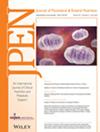Association between heparin addition to parenteral nutrition and catheter-related complications in very preterm infants: A retrospective cohort study
Abstract
Background
This study aimed to assess the necessity of adding heparin to parenteral nutrition for continuous infusion through a peripherally inserted central catheter in very preterm infants.
Methods
This retrospective cohort study was conducted between January 1, 2019, and January 1, 2023. Preterm infants with gestational age <32 weeks requiring a peripherally inserted central catheter for parenteral nutrition were included. The heparin group received parenteral nutrition with 0.5 IU/ml heparin added for infusion through a peripherally inserted central catheter, whereas the nonheparin group did not receive heparin. Propensity score matching was used to balance baseline variables between the two groups. The primary outcome was the incidence of catheter-related complications. A noninferiority margin of 10% was chosen. Nonelective catheter removal, heparin-related side effects, and catheter dwell time were compared between the two groups.
Results
A total of 1089 very preterm infants were included. After propensity score matching, 432 infants from each group were analyzed. The incidence of catheter-related complications was 22.9% in the heparin group and 21.8% in the nonheparin group, with an absolute difference of −1.16% (95% CI: −6.71% to 4.40%). The upper bound was below 10% (P for noninferiority < 0.001), confirming noninferiority. In addition, no significant difference was found between the two groups in the incidence of nonelective catheter removal or heparin-related side effects.
Conclusion
Parenteral nutrition without heparin was noninferior to the addition of heparin during infusion through peripherally inserted central catheter on the risk of catheter-related complications in very preterm infants.


 求助内容:
求助内容: 应助结果提醒方式:
应助结果提醒方式:


